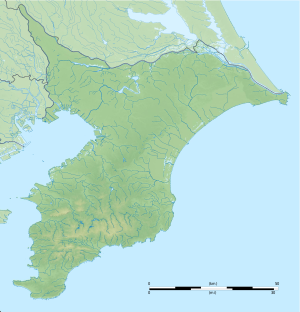Sakura Castle
| Sakura Castle | ||
|---|---|---|
|
Sakura castle complex |
||
| Creation time : | before 1590 | |
| Castle type : | Hirayamajiro (hill castle) | |
| Conservation status: | only ramparts and ditches are preserved | |
| Place: | Sakura | |
| Geographical location | 35 ° 43 '19.2 " N , 140 ° 13' 0.2" E | |
|
|
||
The castle Sakura ( Japanese 佐倉城 , Sakura-jō ) is located in the city of Sakura , Chiba Prefecture . In the Edo period , twelve larger Fudai daimyo resided there one after the other , most recently the Hotta with an income of 100,000 koku .
Lords of the castle in the Edo period
- From 1602 the fifth son of Tokugawa Ieyasu , Takeda Nobuyoshi (1583-1603), with 50,000 koku.
- From 1607 a branch of the Ogasawara with 28,000 koku.
- From 1610 a branch of the Doi with 32,000 koku.
- From 1623 a branch of the Ishikawa with 70,000 koku.
- From 1635 the Katahara Matsudaira with 40,000 Koku.
- From 1642 a branch of the Hotta with 110,000 Koku.
- From 1723 a branch of the Matsudaira (Ogyū) with 60,000 Koku.
- From 1678 a branch of the Ōkubo with 83,000 koku.
- From 1686 a branch of Toda with 61,000 Koku.
- From 1701 a branch of the Inaba with 102,000 Koku.
- From 1723 again a branch of the Matsudaira (Ōgyū) with 60,000 Koku.
- From 1746 a branch of the Hotta with 10,000 koku again.
history
On the orders of Tokugawa Ieyasu , his vassal Doi Toshikatsu ( 土井 利 勝 ; 1573-1644) built the Sakura castle from 1610 into a contemporary castle over the course of seven years. The system, which was left incomplete by Messrs Chiba in the Sengoku period, was used.
The core of the castle, the Hommaru, lies in the western area of a hill which is enclosed by the rivers Kashima ( 鹿島 川 , Kashima-kawa ) and Takasaki ( 高崎 川 , Takasaki-gawa ). That is why the second castle area, the Ni-no-maru, and in the east the third area, the San-no-maru, and in the north the area called Sō-kuruwa ( 総 曲 輪 ) are laid out. Extensive ramparts were built using the natural depression of the Inaba swamp ( 稲 葉 沼 , Inaba-numa ). Since the area did not have any quarries, these were built exclusively as earth walls.
The castle had a castle tower which, when viewed from the outside, consisted of three floors, but had four floors inside. The central area, which contained the residence, was also protected by two watchtowers. This new facility was named Sakura Castle instead of the old name Kashima when it was completed . In 1799 the residence was moved to the third castle area. The castle tower burned down in 1813.
After the Meiji Restoration in 1868, the castle was demolished. Only ramparts and moats that form the castle park have been preserved. Within the park is the National Museum of Japanese History, opened in 1983 .
Remarks
- ↑ The last of the family, Chiba Shigetane ( 千葉 重 胤 ), was expelled by Tokugawa vassals in 1590.
literature
- Sugai, Yasuo: Sakura-jo in: Miura, Masayuki (Ed.): Shiro to jinya. Tokoku-hen. Gakken, 2006. ISBN 978-4-05-604378-5 , p. 100.
- Miyaji, Saichiro (Ed.): Bakumatsu shoshu saigo-no hanshu-tachi. Higashinihon-hen. Jinbunsha, 1997. ISBN 978-4-7959-1905-1 .
- Papinot, Edmond: Historical and Geographical Dictionary of Japan. Reprinted by Tuttle, 1972 edition of 1910 edition. ISBN 0-8048-0996-8 .

